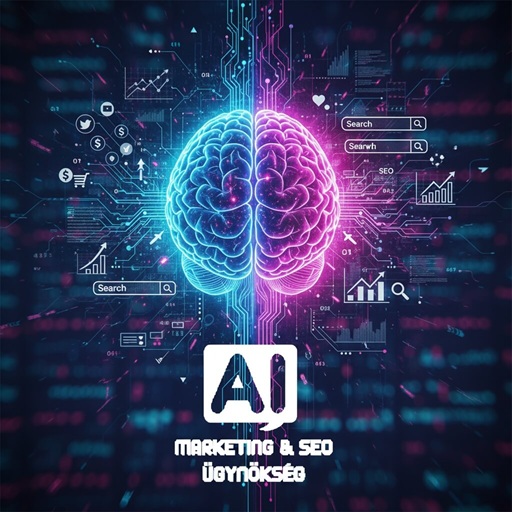 Van egy újfajta feszültség a levegőben. Egyfajta digitális sürgetés, ami mára minden cégvezető irodájába beszivárgott. Ez a "MI-pánik". A felismerés, hogy a mesterséges intelligencia nem egy távoli, ködös jövőkép, hanem a kőkemény jelen. Mindenki érzi, hogy lemarad, ha nem lép. De a legtöbben, őszintén szólva, egyszerűen megbénultak.
Van egy újfajta feszültség a levegőben. Egyfajta digitális sürgetés, ami mára minden cégvezető irodájába beszivárgott. Ez a "MI-pánik". A felismerés, hogy a mesterséges intelligencia nem egy távoli, ködös jövőkép, hanem a kőkemény jelen. Mindenki érzi, hogy lemarad, ha nem lép. De a legtöbben, őszintén szólva, egyszerűen megbénultak.
Miért? Mert az MI ijesztőnek tűnik. Komplexnek. És főleg: felfoghatatlanul drágának és időigényesnek.
A legtöbb cégvezető fejében ez a kép él: ha MI-stratégiát akarok, az egyet jelent hat-tizenkét hónapnyi auditálással, elemzők hadával, akik interjúkat készítenek, végtelen workshopokkal, és egy olyan árcédulával, ami egy kisebb cég teljes éves költségvetésével vetekszik. Ez a hagyományos tanácsadói modell. És a legfájdalmasabb az egészben? Mire a 150 oldalas stratégiai dokumentum elkészül, addigra a technológia, amire épült, már el is avult.
Ez a "bénultság az elemzés által" (paralysis by analysis). És a mai világban ez a legnagyobb üzleti kockázat. A félelem a költségektől és az időráfordítástól erősebb, mint a félelem a lemaradástól.
De mi lenne, ha az egész folyamatot a feje tetejére állítanánk? Mi lenne, ha a megoldás nem a még több elemzés, hanem a drasztikusan kevesebb lenne? Mi lenne, ha azt mondanám, hogy a mély, cselekvésre kész MI-stratégia megszerzése nem hónapok, hanem napok, sőt, néha percek kérdése?
Pontosan ez az ígérete a "Nagy Sebességű, Nagy Hatású" (High-Velocity, High-Impact, vagyis HVHI) modellnek. Ez a Roth AI és Roth Miklós által alkalmazott filozófia szembemegy mindennel, amit a "nagy" tanácsadásról gondoltunk. Azt mondja: miért várna az eredményekre, ha azonnal el lehet kezdeni?
Ebben a cikkben mélyebbre ásunk, és megvizsgáljuk, miért van égető piaci igény a sebességre és a mérhető, azonnali javulásra, és hogyan működik az a mechanizmus, ami a HVHI-modell mögött rejlik, és ami kíméletlenül kiiktatja a hagyományos folyamatok felesleges költségeit (overhead).
A "holnap" csapdája (a hagyományos modell rejtett költségei)
Ahhoz, hogy megértsük a HVHI-modell forradalmiságát, először meg kell értenünk, miért drága és lassú a régi rendszer. A válasz egyetlen szóban: az "overhead". Vagyis a felesleges, hozzáadott értéket alig termelő költségek halmaza.
A hagyományos MI-tanácsadás egy monumentális, nehézkes folyamat. A probléma az, hogy az ösztönző rendszer a lassúságra és az erőforrás-pazarlásra épül, nem a gyors eredményre.
A 95%-os felesleg anatómiája
Amikor egy cég 6-12 hónapos tanácsadói szerződést ír alá, valójában miért fizet? A valós szakértelem gyakran a teljes költség alig 5-10%-a. A maradék 95% ez:
-
A "betanulási" fázis: A tanácsadó cég kihelyez egy 5-10 fős csapatot, tele lelkes, de az iparágat nem ismerő junior elemzőkkel. Az első 2-3 hónapjuk azzal telik, hogy interjúkat készítenek, workshopokat tartanak, és alapvetően az ön cégén, az ön pénzén tanulják meg az iparágat. Ez tiszta "overhead".
-
Az utazás és a bürokrácia: A globális tanácsadás egyet jelent a business class repjegyekkel, a drága szállodákkal, az egész napos, cateringgel ellátott meetingekkel. Ezek mind felesleges költségek egy olyan világban, ahol a csúcsszintű stratégia egy Zoom-híváson is átadható.
-
A "biztonsági játék" (CYA - Cover Your Ass): A nagy cégek rettegnek a felelősségtől. Ezért minden egyes apró részletet auditálnak, minden adatbázist feltérképeznek, még azokat is, amiknek semmi közük a valós üzleti problémához. Azért teszik, hogy a végén elmondhassák: "mi mindent megvizsgáltunk". Ez a "régészeti feltárás" hónapokkal lassítja a projektet.
-
A 150 oldalas "tanulmány": A leglátványosabb pazarlás. A folyamat végén megszületik egy vastag, gyönyörűen bekötött PDF, tele iparági "buzzword"-ökkel, komplex diagramokkal és elméleti jövőképekkel. Ezt a dokumentumot a vezetőségből szinte senki sem olvassa el végig. A célja nem a cselekvés, hanem a projekt lezárása és a végszámla igazolása.
Ez a modell nemcsak drága, de mire a végére ér, a cég kimerül. A lelkesedés elpárolog, a világ pedig elhaladt mellette. Az MI-korában a lassúság a legnagyobb luxus, amit egy cég megengedhet magának.
A piaci igény: a sebesség mint az új valuta
A piac felébredt. A COVID-járvány megmutatta, hogy a digitális átállás, amire a cégek korábban 5 évet szántak, elvégezhető 5 hét alatt, ha a kényszer ránk zárja az ajtót. A Generatív MI (mint a ChatGPT) berobbanása pedig megmutatta, hogy a forradalom nem holnap jön, hanem tegnap volt.
A mai cégvezető már nem hisz a lassú, monumentális tervekben. Az új piaci igény radikálisan más.
-
Azonnali Eredmény (ROI) az Elmélet Helyett A mai vezetőt nem az érdekli, mi lesz 10 év múlva. Azt akarja tudni, hogyan spórolhat 15%-ot a költségein a következő negyedévben. Nem egy 200 oldalas stratégiai dokumentumot akar, hanem egy 3 pontos cselekvési tervet, amit holnap reggel kiadhat a csapatának. A mérhető, azonnali javulás iránti igény mindent felülír.
-
Sebesség a Tökéletesség Helyett A régi modell a 100%-os, kockázatmentes megoldást kereste. Az új modell tudja, hogy a 100% elérhetetlen és lassú. A 80%-os megoldás ma többet ér, mint a 100%-os megoldás 6 hónap múlva. A piac a gyors kísérletezést, a gyors tanulást és a gyors iterációt díjazza.
-
Agilitás a Bürokrácia Helyett A "nagy, kockázatos projekt" helyett a cégek kis, menedzselhető lépéseket akarnak tenni. "Próbáljunk ki egy dolgot. Mérjük le. Ha működik, csináljunk többet belőle. Ha nem, dobjuk ki, és próbáljunk mást." Ez az agilis és "lean" (karcsú) gondolkodásmód.
Ez a három piaci igény az, ami a hagyományos tanácsadói modellt halálra ítéli, és ami utat nyit a HVHI-modellnek.
A HVHI (nagy sebességű, nagy hatású) modell definíciója
A HVHI-modell egy filozófia, mielőtt még folyamat lenne. Azt mondja: a tanácsadás értékének 95%-a a diagnózisban és a cselekvési tervben van, nem a közte lévő, hónapokig tartó adminisztrációban.
Nagy Sebesség (High-Velocity): Ez a 95%-os vágás. Ez azt jelenti, hogy kíméletlenül kiirtunk minden "hulladékot" (overhead) a folyamatból.
-
Nincs utazás.
-
Nincsenek egész napos workshopok.
-
Nincs junior elemzői csapat, ami "betanul".
-
Nincs 100 oldalas riport.
-
Van helyette: egy extrém módon fókuszált, rövid (néha csak 20 perces) ülés, ami egyetlen dologra koncentrál: a megoldásra.
Nagy Hatás (High-Impact): Ez a "mérhető, azonnali javulás" ígérete. A HVHI-modell nem azzal foglalkozik, hogy "hogyan lehetne 10 év múlva az iparágunk legjobbja". Azzal foglalkozik, hogy "mi az a 20% probléma, ami a kár 80%-át okozza, és hogyan oldjuk meg 2 héten belül". A HVHI-modell nem egy átfogó stratégiát ad, hanem egy tőkeáttételes beavatkozási pontot (leverage point) keres. Azt a pontot a rendszerben, ahol a legkisebb beavatkozás a legnagyobb pozitív változást eredményezi.
A mechanizmus: hogyan szállít a HVHI mérhető hatást azonnal?
A HVHI-modell lényege, hogy a hónapokig tartó, passzív "tanulmányírást" egy aktív, gyors "kísérletezési ciklusra" cseréli.
1. A "fordított" adatgyűjtés (az overhead kiiktatása)
A HVHI-modell is adatvezérelt, de radikálisan máshogy.
-
Régi modell: A tanácsadó jön, és 3 hónapig gyűjti az adatokat.
-
HVHI modell: A tanácsadó (pl. Roth Miklós) már az első találkozó előtt bekéri a kulcsadatokat.
A folyamat egy Diagnosztikai Előkészítéssel kezdődik. Ez nem egy technikai audit, amitől az IT-részleg a falra mászik. Ez egy kőkemény üzleti fájdalompont-audit. Egy célzott, lézerpontos kérdőív, ami nem az IT-rendszerekre, hanem az üzleti veszteségekre fókuszál.
Példa kérdések a diagnosztikai csomagból:
-
"Sorolja fel azt a 3 feladatot a cégében, ami a legtöbb repetitív, alacsony hozzáadott értékű emberi munkát igényli." (Azonnali automatizálási célpontok).
-
"Hol van az a 'duguló' (bottleneck) a folyamatban, ahol az ügyfelek lemorzsolódnak vagy a legtöbbet panaszkodnak?" (Azonnali bevételnövelési pont).
-
"Milyen adatokkal rendelkezik, amikről úgy érzi, 'aranybányán ül', de jelenleg nem használja semmire?" (Rejtett lehetőségek).
A tanácsadó már nem nulláról indul. Amikor a "stopper elindul" (a fókuszált ülés), a tanácsadó már egy előzetes diagnózissal, egy hipotézissel érkezik az asztalhoz. A tanácsadó ideje nem a tényfeltárással telik (azt elvégezte az ügyfél), hanem a megoldás-generálással. A 3 hónapos "Felfedező" fázist ezzel helyettesítették.
2. A "lean" megoldás (a tökéletes helyett a lehetséges)
A HVHI-ülés (legyen az 20 perc vagy 2 óra) nem egy "brainstorming", ahol ötletelnek. Ez egy "sebészeti beavatkozás".
A tanácsadó az előkészített adatok alapján felvázolja a diagnózist: "Úgy látom, a legnagyobb problémája nem az új ügyfelek szerzése, hanem a meglévő ügyfelek panaszainak lassú kezelése. A heti 40 óra manuális email-válogatás a jelenlegi legnagyobb pénznyelő. Jól látom?"
Miután a probléma azonosítva van, a "lean" elv lép életbe. Ahelyett, hogy egy 50 millió forintos egyedi MI-t javasolna, a tanácsadó a "legkönnyebben elérhető gyümölcsre" (low-hanging fruit) fókuszál.
"Felejtse el a saját rendszer építését erre a célra. Ahelyett, hogy lecserélnénk a CRM-et, kössünk rá a meglévő levelezésükre egy 'plug-and-play' chatbotot vagy egy automatizációs eszközt, ami a beérkező emailek 60%-át azonnal kategorizálja és a megfelelő emberhez irányítja. Ez 3 hét alatt bevezethető, a költsége pedig havi 100 dollár."
A HVHI-ülés kimenetele nem egy 150 oldalas tanulmány, hanem egy 3-5 pontos, azonnali cselekvési terv. Egy recept, amit a cégvezető holnap reggel elkezdhet "megfőzni". Ezzel a 9 hónapos elemzési és riportolási fázist vágták ki a folyamatból.
3. Az azonnali kísérlet (az "építs-mérj-tanulj" hurok)
Ez a "mérhető MI-hatás azonnal" ígéretének kulcsa. A HVHI-modell nem azt ígéri, hogy 20 perc alatt megoldja a problémát. Azt ígéri, hogy 20 perc alatt elindítja a megoldási folyamatot.
A "lean" módszertan alapja az "Építs-Mérj-Tanulj" (Build-Measure-Learn) ciklus.
-
A hagyományos tanácsadás 6 hónapot tölt a "Tanulj" (elemzés) fázisban, és a végén javasol egy hatalmas "Építs" projektet.
-
A HVHI-modell 20 perc alatt ad egy pici "Építs" feladatot, hogy a cég már a 2. napon elkezdhessen "Mérni", és a 8. napon már "Tanuljon" a valós adatokból.
Nézzünk egy példát:
A probléma: Egy közepes KKV marketingese hetente 10 órát tölt azzal, hogy a weboldalra érkező "érdeklődőket" (leadeket) manuálisan minősítse, és továbbítsa az értékesítőknek. A vezetők panaszkodnak, hogy az értékesítők idejét rossz minőségű érdeklődők rabolják.
A HVHI-megoldás (1 hetes ciklus):
-
Nap 0: A marketingvezető kitölti a diagnosztikai űrlapot. Fájdalompont: "Túl sok idő megy el a lead-ek minősítésével, alacsony a konverzió."
-
Nap 1 (a 20 perces ülés): A tanácsadó javaslata: "Ne vegyenek új CRM-t. Használjunk egy MI-eszközt, ami az űrlap adatait és az email szövegét elemezve automatikusan pontozza az érdeklődőket 1-től 5-ig. Az értékesítők csak a 4-es és 5-ös szintűekkel foglalkozzanak." Az akcióterv: 1. Regisztráljanak az X eszközre. 2. A marketinges 1 óra alatt tanítsa be az MI-t 50 korábbi jó és 50 rossz lead alapján. 3. Egy hétig fussanak párhuzamosan a régi és az új rendszerrel.
-
Nap 8 (Mérés): Az eredmények: Az MI 90%-os pontossággal eltalálta a "jó" leadeket. A marketinges heti 10 órája felszabadult. Az értékesítők csak a releváns ügyfelekkel beszéltek, a konverziós arányuk 30%-kal nőtt.
Ez az azonnali, mérhető MI-hatás. A cég 8 nap alatt nagyobb eredményt ért el, mint a versenytárs, aki 8 hónapja tervezi az új CRM-rendszert.
A pszichológiai váltás (a bénultságtól a lendületig)
A HVHI-modell legnagyobb hatása nem is technológiai, hanem pszichológiai. A "projektbénultság" egy negatív spirál. Minél tovább elemzel, annál több problémát találsz, annál nagyobbnak tűnik a feladat, és annál kisebb az esélye, hogy belevágsz.
A 20 perces, "nagy sebességű" audit egy "defibrillátor" egy megállt szívű projekt számára. Egy gyors, éles sokk, ami kimozdítja a rendszert a holtpontról.
A cél nem az, hogy 20 perc alatt megoldjuk a cég összes problémáját. A cél az, hogy elindítsuk az első mérhető győzelmet. A pszichológiában ezt "momentum"-nak, lendületnek hívják. Amikor az a kis, 1 hetes kísérlet működik, a csapat önbizalmat kap. A bénultság helyét átveszi az izgatottság. "Működött! Mi a következő lépés?"
Ez a "flywheel effect" (lendkerék-hatás). Az első kis lökés a legnehezebb. De ha az megvan, a következő fordulat már könnyebb lesz. A második kísérlet gyorsabban indul, a harmadik már nagyobb merészségű lesz.
A globális pálya: miért ez a tanácsadás jövője?
A HVHI-modell azért a jövő, mert a globális piac igényeire ad választ. A régi modell azért volt drága és lassú, mert a "globális szakértelmet" fizikailag kellett mozgatni. Ha egy magyar cég a McKinsey New York-i MI-szakértőjével akart beszélni, ki kellett fizetnie a repülőjegyét, a business class szállodáját és a csillagászati napidíját. Ez a modell a Fortune 500-as cégek kiváltsága volt.
A HVHI-modell digitális és "lean". A COVID-járvány megtanította a világnak, hogy a magas szintű stratégiai munka tökéletesen működik távolról. A "Stopper Stratégia" mechanizmusa (a diagnosztikai előkészítés és a fókuszált online ülés) lehetővé teszi, hogy a világ legjobb szakértői a fizikai jelenlét "overhead"-je nélkül dolgozzanak.
Egy HVHI-modellben dolgozó tanácsadó (mint Roth Miklós) lehet bárhol. Tarthat egy fókuszált, nagy hatású MI-auditot egy szingapúri startupnak reggel 9-kor, egy budapesti KKV-nak délelőtt 11-kor, és egy brazil nagyvállalati részlegnek délután 3-kor.
Ez a tanácsadás demokratizálódása. Egy agilis magyar KKV ma már ugyanazt a csúcsszintű stratégiai gondolkodást kaphatja meg (sőt, gyorsabban!), mint egy multinacionális óriás, mert már nem kell megfizetnie a tanácsadó cég utazási és fenntartási költségeit. Csak a tiszta szakértelmet fizeti meg, percre (vagy projektre) pontosan.
A cselekvés mint az új stratégia
Az MI-forradalom nem fog várni. Nem fog várni a hat hónapos auditokra, a 150 oldalas tanulmányokra és a negyedéves bizottsági ülésekre. Az MI most történik, valós időben.
A piac égető igénye a sebességre és a mérhető eredményekre egy új modellt kényszerített ki. A HVHI-modell erre a piaci igényre adott válasz. Felismerte, hogy a 21. században a tanácsadásnak is olyanná kell válnia, mint maga a technológia, amiről tanácsot ad: gyorsnak, agilisnak, adatvezéreltnek és globálisan elérhetőnek.
A "Stopper Stratégia" nem csak arról szól, hogy 95%-kal csökkentjük az időt. Arról szól, hogy 95%-kal csökkentjük a bénultság idejét. Arról, hogy a "mit kéne tenni?" homályos félelméből "ezt fogom holnap csinálni" tiszta cselekvést faragunk. És ebben a felgyorsult világban az nyer, aki gyorsabban jut el a cselekvésig.
 In the realm of modern search engine optimization, many brands make the mistake of focusing solely on external backlinks while neglecting their own site’s architecture. An AI Link building agency specializing in Internal Linking understands that internal structure is the ultimate force multiplier for your external efforts. By implementing a sophisticated hub-spoke architecture, precise anchor mapping, and crawl depth improvements, you can ensure that the authority gained from high-quality backlinks is distributed efficiently across your entire domain.
In the realm of modern search engine optimization, many brands make the mistake of focusing solely on external backlinks while neglecting their own site’s architecture. An AI Link building agency specializing in Internal Linking understands that internal structure is the ultimate force multiplier for your external efforts. By implementing a sophisticated hub-spoke architecture, precise anchor mapping, and crawl depth improvements, you can ensure that the authority gained from high-quality backlinks is distributed efficiently across your entire domain. Van egy újfajta feszültség a levegőben. Egyfajta digitális sürgetés, ami mára minden cégvezető irodájába beszivárgott. Ez a "MI-pánik". A felismerés, hogy a mesterséges intelligencia nem egy távoli, ködös jövőkép, hanem a kőkemény jelen. Mindenki érzi, hogy lemarad, ha nem lép. De a legtöbben, őszintén szólva, egyszerűen megbénultak.
Van egy újfajta feszültség a levegőben. Egyfajta digitális sürgetés, ami mára minden cégvezető irodájába beszivárgott. Ez a "MI-pánik". A felismerés, hogy a mesterséges intelligencia nem egy távoli, ködös jövőkép, hanem a kőkemény jelen. Mindenki érzi, hogy lemarad, ha nem lép. De a legtöbben, őszintén szólva, egyszerűen megbénultak.
 Van az a hang. Az a halk, de kitartó, a megszokott otthoni zajok közül alattomosan kiszűrődő csepegés az éjszaka közepén. Vagy az a jéghideg felismerés, amikor a fürdőszobából kilépve egy tócsába lépsz a folyosón. Esetleg a falon lassan, de megállíthatatlanul terjedő, sötét folt látványa. A legrosszabb pedig a földgáz jellegzetes, rothadt tojásra emlékeztető "illata", vagy a fűtésrendszer halálos csendje a leghidegebb téli reggelen.
Van az a hang. Az a halk, de kitartó, a megszokott otthoni zajok közül alattomosan kiszűrődő csepegés az éjszaka közepén. Vagy az a jéghideg felismerés, amikor a fürdőszobából kilépve egy tócsába lépsz a folyosón. Esetleg a falon lassan, de megállíthatatlanul terjedő, sötét folt látványa. A legrosszabb pedig a földgáz jellegzetes, rothadt tojásra emlékeztető "illata", vagy a fűtésrendszer halálos csendje a leghidegebb téli reggelen.



